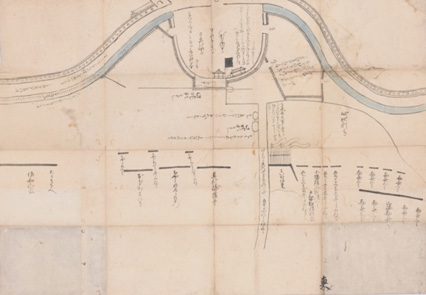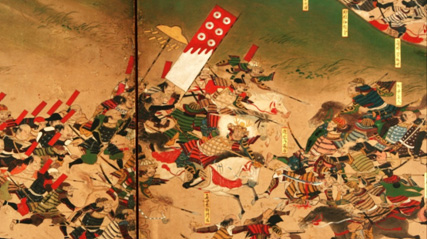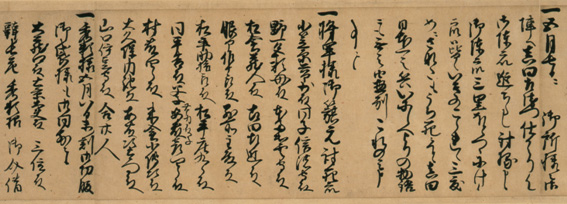
A letter written by Sanada Nobushige to Sakyo;
a cultural property designated by Wakayama prefectural government
held in the collection of the temple, Rengejo-in, Mt. Koya; dated June 23 (year unknown)
*Exhibition period: September 17 (Sat.) to October 3 (Mon.), 2016

A drawing showing the formation of troops of the Kaga domain
for the offensive against Osaka Sanada Maru
held in the collection of Eisei-Bunko Museum; from the Edo period
(Shown in the Osaka Museum of History only)
*Exhibition period: September 17 (Sat.) to November 6 (Sun.), 2016

This drawing depicts the U-shaped structure of the Sanada Maru fortress protruding southward from the outermost enclosure of Osaka Castle. Inside the Sanada Maru fortress, we can see the names of Sanada Saemon (Nobushige) and other warriors in the Sanada troops, as well as a black square-shaped flag that indicates the location of the head of the Sanada clan. In the lower part of the drawing are written the names of the warriors in the troops of Maeda Toshitsune, who played a central role in the offensive against the Sanada Maru fortress during the Winter Campaign. It was drawn based on information gained during an on-the-spot investigation of the battlefield conducted immediately after the Winter Campaign. Therefore, this is one of few records that tell us what the Sanada Maru fortress, which is now completely lost, was like.
A pair of six-panel folding screens depicting
the Summer Campaign of the Siege of Osaka
held in the collection of Gifu City Museum of History; from the Edo period
(Shown in the Osaka Museum of History only)
*Exhibition period: October 12 (Wed.) to November 6 (Sun.), 2016

(Part of screen) Nobushige is depicted in the center on horseback fighting
the troops of the Echizen domain.
These folding screens depict the fierce battles on May 6 and 7, 1615 that brought an end to the Summer Campaign of the Siege of Osaka. In the upper part and the lower part of the right screen are depicted, respectively, the troops led by Sanada Nobushige fighting against the troops of the Echizen domain in the battle of Tennoji on May 7, and the troops led by Goto Mototsugu, surrounded by large Tokugawa forces in Tamateyama on May 6. The lower part of the left screen portrays a scene of the Tokugawa forces entering Osaka Castle and soldiers in the castle fighting back. Nobushige died in the battle on May 7.
National treasure:
A letter presumed to have been written
by Shimazu Iehisa
(the beginning of the letter is missing);
documents of the Shimazu family
held in the collection of Historiographical Institute of the University of Tokyo; dated June 11, 1615
(Shown in Osaka Museum of History only)
*Exhibition period: October 19 (Wed.) to November 6 (Sun.), 2016

(Part of letter) The 6th and 7th lines from the right read
“Sanada was the greatest samurai warrior in Japan.”
After the fall of Osaka Castle, Shimazu Iehisa of the Satsuma domain travelled to Kyoto and gave a congratulatory message to Tokugawa Ieyasu for his victory in the battle against the Toyotomi clan. Dated June 11, 1615, this letter is presumed to have been written by Shimazu Iehisa to his family in Satsuma. The letter describes how the battle was fought and contains a list of people who died in Osaka Castle, starting with Toyotomi Hideyori who committed hara-kiri. Nobushige’s son, Sanada Daisuke, is among the list of the people who died. A passage of this letter that refers to Nobushige, which is widely known says, “Sanada was the greatest samurai warrior in Japan, having no equal even in stories from ancient times.”
Important cultural property:
A naginata-turned katana without a signature
(Designated as a masterpiece, Honebami Toshiro)
held in the collection of Toyokuni Shrine, Kyoto; from the Kamakura period
(Shown in Osaka Museum of History only)
*Exhibition period: October 12 (Wed.) to October 24 (Mon.), 2016

This katana was made by polishing a naginata long sword and reducing its length to that of a katana. Though the katana bears no signature of swordsmith, it was reportedly produced by Toshiro Yoshimitsu, a master swordsmith in Kyoto. It is called “Honebami” meaning “bone eater,” which comes from a legend that a man could cut through the bones of an opponent just by pretending to cut him. Originally, the katana was treasured by the Ashikaga shogunate’s family and then by Toyotomi Hideyoshi, and came into the possession of Tokugawa Ieyasu during the confusion of the Summer Campaign of the Siege of Osaka. In 1657, the katana was damaged in a great fire and lost its temper line. However, this was restored by Yasutsugu III, a master swordsmith in Echizen.

This letter was written by Sanada Nobushige to a person named Sakyo while he was under house arrest in Kudoyama, Kishu (present-day Wakayama Prefecture), after the Battle of Sekigahara. The letter reads “Please fill this pot with shochu (distilled liquor), tighten the pot securely, and put a piece of paper on it. I will send someone to fetch it when notified that you are ready.” This letter is a very valuable material as it is indicative of the humble life he lived while under house arrest.